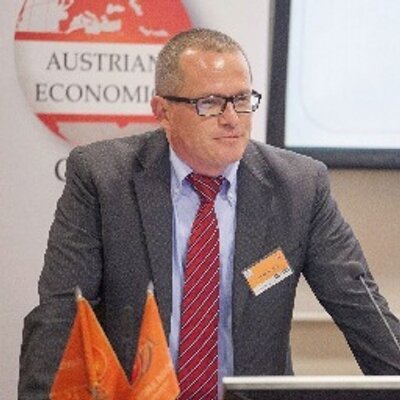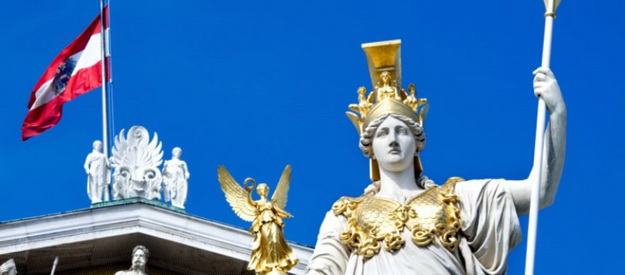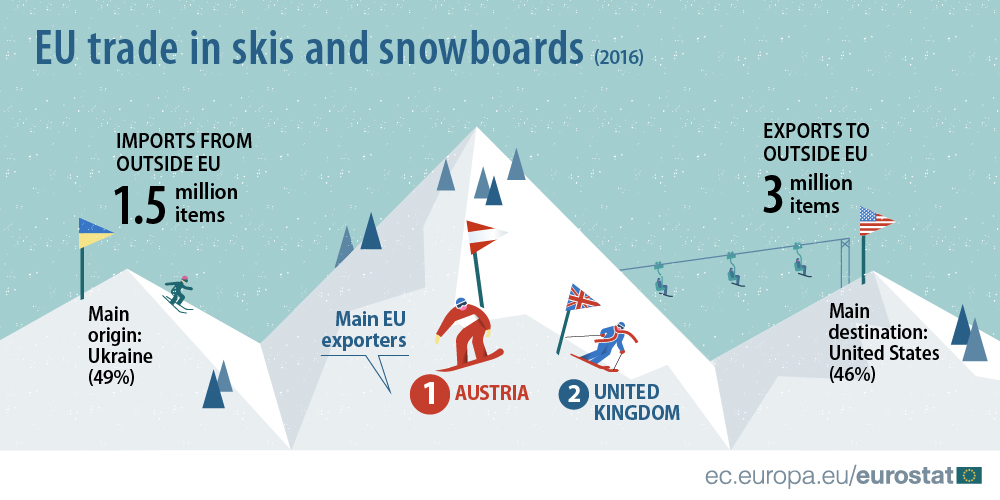There are powers in the world and in Ukraine advocating neutrality based on the Austrian model. Considering how rich Austria is today, it is tempting to claim its success is connected to its neutrality and based on this to attempt to export the Austrian model.
Look, that would be a tragic mistake, leading to an even more tragic result. It would be based on a wrong perception of Austrian history and neutrality and would result not only in the end of a European Ukraine but in the end of Ukraine as an independent state, and its return under Russian hegemony.
There are many myths about Austria and Austrian neutrality and we have to work step by step to destroy them to avoid Ukraine falling into the trap of neutrality based on an erroneously perceived Austrian model.
Austria never wanted to be neutral. We were forced to neutrality by the liberation forces of the allied winners of World War II occupying Austria for 10 long years. Neutrality as a bargaining price for unity and independence and to buy Soviet power into leaving Austria. The Soviets wanted it, not the Austrians.
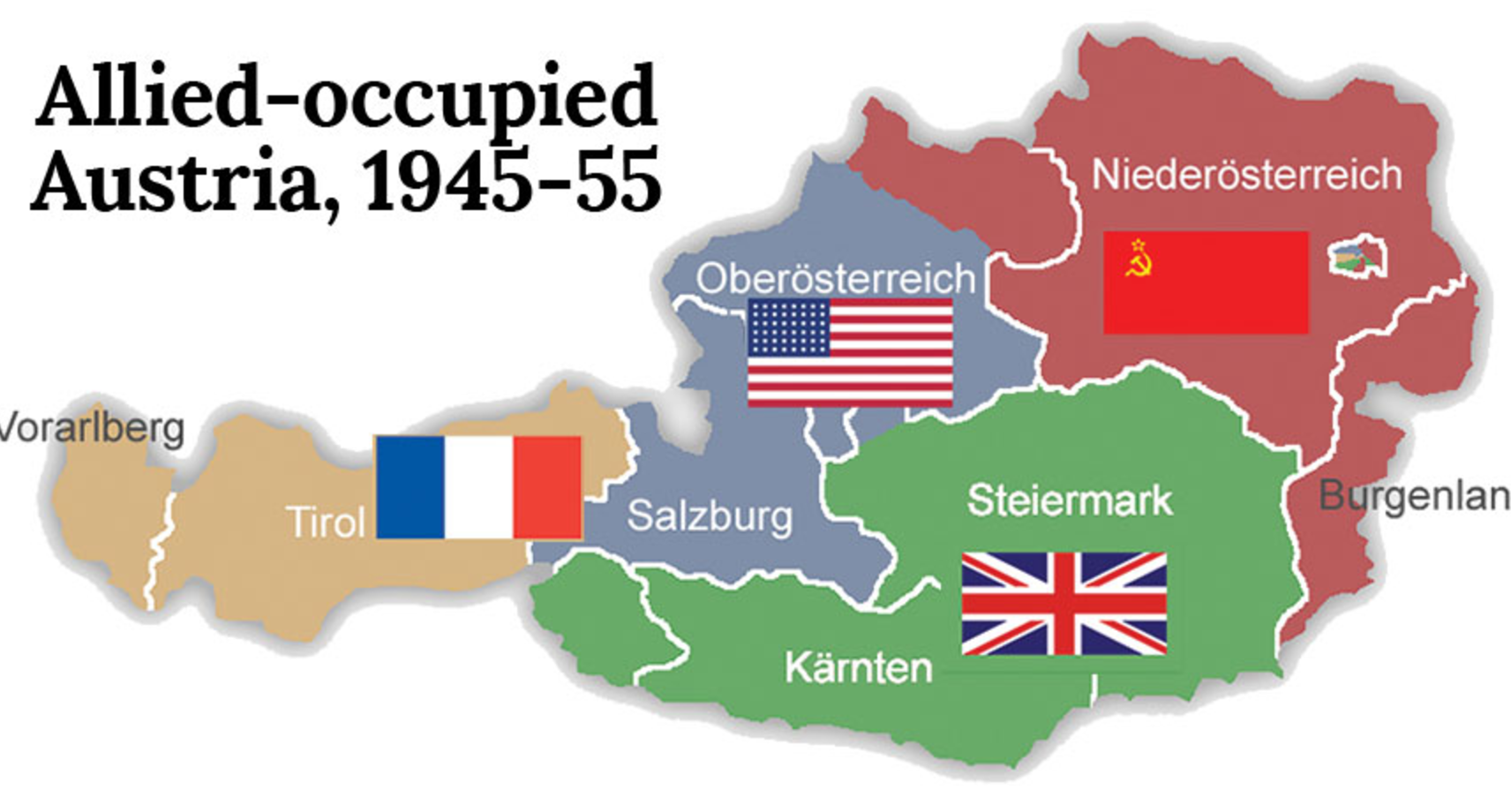
Main objective: getting rid of Soviet occupation
People really did not like the occupation by the "liberators" starting from 1945, and with each year the Austrians liked it less. Especially they hated to be occupied by the Soviets who abused their force and power to take revenge and kill and abduct those who they preferred, considering them dangerous, useful, or for whatever other reason destined for Siberia.
It is quite understandable that both the Austrian citizens and elite were ready for a lot to get rid of them and chose neutrality. But did the elite and people think neutrality would be a tool for prosperity or was it to them a necessary evil, part of the deal to get rid of Soviet powers occupying half of Vienna and third of Austria, including its most fertile and industrially developed parts? I can assure you it's the second.
The death of Stalin in 1953 and the power struggle of his successors presented a moment of opportunity for the Austrian elite, which would have been already lost in 1956, with the Suez crisis ongoing, power consolidated in Moscow, and the Hungarian revolution triggering fears of the same thing repeating in Austria. So well done, Julius Raab, Leopold Figl and all the great heroes of Austrian independence, who traded Austria's unity and independence for neutrality.
But were they believers in neutrality like the Swiss? Were they thinking they can maneuver between the East and West like Yugloslavian President Tito did later? These leaders were Christian land owners and farmers turned political leaders, having spent much time in German concentration camps and having seen of a failed Soviet coup in October 1950 in Austria, the Soviets take over in all former Austro-Hungarian Monarchy territory and had for sure a clear understanding of their own limits, power, and defense capabilities back.
The real power then and now in free Europe was and is with America. It's hard to imagine that Julius Raab and Leopold Figl would have sneaked from Lower Austria to Moscow to broker a quick and dirty deal with Moscow for Austria's unity, independence, and neutrality without America's consent. For the USA, this was a useful experiment to test the waters, show that Soviet power can retreat in a territory that didn't matter as much and create a neutral zone to meet and do business with the Soviets in Vienna.
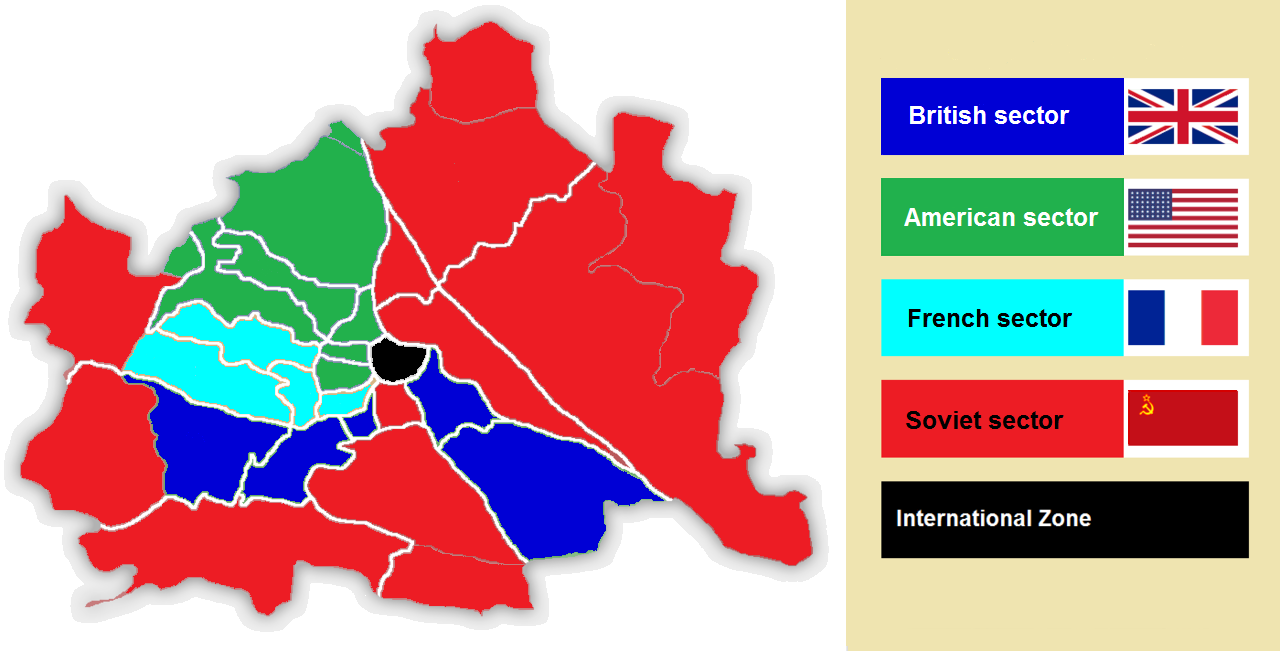
But it was clear that Austrian neutrality could work only under American security protection, and financial help for reconstruction. But it was an experiment which could not have been repeated in Germany, as the flat northern plains of Europe, unlike the hills of Austria, were an open runway for Soviet tanks which could travel from Poland to the Atlantic in a matter of a day. A neutral Germany torn between East and West, open to Soviet agitation and a possible takeover, was not possible in the industrial power of Europe bordering both sides of the Rhine river. German neutrality would have been the end of a pro-American Western Europe: the offer of Germany neutrality was rejected and Chancellor Konrad Adenauer called Austrian efforts an international socialist scandal.
It must be, however, mentioned that the Austrian Socialists had their own historic reasoning and connections with the Soviet Union and the Communist International of the Soviet Union. Despite this, they had their own form of Communist Authoritarianism and they have to be credited for defeating the communist coup in 1950 which was defeated by Social-Democrat Trade Union commandos with the silent consent of the US forces. The Austrian Social Democrats had an own ideological proud basis and confident enough to resist Communist temptations. We have to respect that, but what really matters was that American allowed it and consented and secured the deal.
Neutrality – a heavy price to pay for Austria
So, neutrality was not meant to be really neutral between two equal good or bad power blocks, but it was the only option to remove and escape Soviet domination, under American consent and support.
Later, this all was mystified and the Austrian elite built its own narrative of success and Austrian exceptionalism. After the failure of the first Austrian republic between 1919 and World War II, the Austrian elites clearly saw in 1955 that they need to develop the identity of the state, develop Austria as a nation.
The state, its elite and people needed such a narrative and it was developed successfully by the nation builders of the time. But during the Cold War, the elite was always clear where Austria stands and who is protecting it. There was no doubt that Vienna is protected by American power unofficially, and it was clear to the Austrian elite that Vienna and Eastern Austria were not defendable by neither the Austrians nor by the Americans anyway, as the realistic defense line ran along the Western German and Western Austrian border and between Western Germany and Italy.
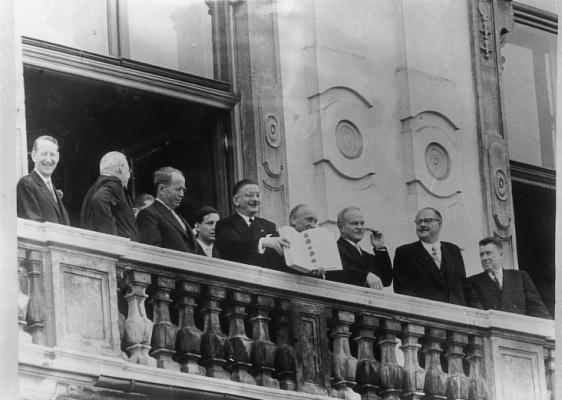
Austria in the 1970s and its defense strategy
Neutral Austria later then adopted a remarkable national defense strategy: in case war erupts between the superpowers, Austria has to show America and the Soviet Union that it can defend the Danube Valley against a Soviet tank army, being able to delay the Soviets from entering southern Germany for at least three days, meaning that the Americans need not drop a tactical nuclear weapon in the Danube plains, more concretely in the straits east of Linz, to stop them, and compel the Soviets from the start to focus on the German border and respect Austrian neutrality.
Sound nuts? But this was it.
The author of this text was trained to die in the Danube plains as part of the last generation of Austrian officers during the Cold War in 1988. If you want to read more it was called Spannocci Doctrine after the Austrian Commanding General drafting it. Luckily, it was never tested.
Sound a bit complicated and what is the meaning for Ukraine? We will come to that in a moment and you will not like it.
Austria after the end of Cold War
Soviet power collapsed due to overextension from Afghanistan to Poland and Cuba, its own incompetence, a breakdown of credibility and loss of legitimacy during Glasnost, and the triple reality of the drop in global commodity prices, complete economic failure, and an armament race they could not win. This was coupled with the reality that capitalism and freedom works and Communism doesn't, which everybody could see in the difference between German, Czech, Slovak, and Hungarian TV as far as the media reception of German and Austrian media could reach.
When Austria reconnected with its markets in the center of Europe and tapped into the power of the EU internal market, it turned into one of the richest countries in Europe. But the myth of neutrality lingered, and some people explained Austrian prosperity not by EU's internal market, the victory of the West in the Cold War, reconnection of historic markets, and American security guarantees, but with the myth of neutrality. When it was possible to change the neutral status during EU accession and shortly afterward, Austria's leaders were too weak, or not ready, or not convinced.
Why Austria did not join NATO after joining the EU in 1995
Austrian anti-Americanism joined the equation in 2000 when Austrian nationalists joined forces. Among them were many who always regretted the loss of WWII, were laden with latent anti-Americanism and were never part of the Austrian elite's silent pro-Western neutrality under US protection consensus, which was a firm pillar of the Austrian elite during the Cold War. The right-wing Freedom Party of Austria was not let anywhere close to power during the Cold War (albeit with 2 minor short term and controversial exceptions). Then came the Iraq war, killing the debate of Austria joining NATO, and covering it in concrete for a decade until now.

Now, Austria is surrounded by NATO fully, save Switzerland. NATO membership sounds expensive, and no political leader of the thrifty Austrian nation, by nature not the most courageous, dares touch such an issue so contentious and complicated as NATO, which has budget implications, needs military reform, irritates the latent and open anti-Americanism of the Austrian left and right, Russian energy and investment interests, traditional links of the Austrian left with Russian leftists and the new links of the Austrian Socialist elite-turned consultants and advisers of Russian oligarchs living in Vienna.
After Ukraine's 2014 Euromaidan revolution, which set Ukraine opting for the West and seriously aspiring to join the EU and NATO, the Austrian elite in all its post-imperial glory saw its opportunity as a bridge builder to enrich the global debate with exporting Austrian neutrality as a success model for Ukraine.
"Hey, we have something to offer to the world as grandchildren of Bruno Kreisky, again we are the best and exceptional and can explain to the world that Austrian neutrality is great for Ukraine! Please become neutral like us and repeat the success, and Austria will again be a bridge between Russia and Europe and we can do great business and live in peace and prosperity for the future," they say.
But is it really a feasible option for Ukraine?
Austrian neutrality in reality under US protection
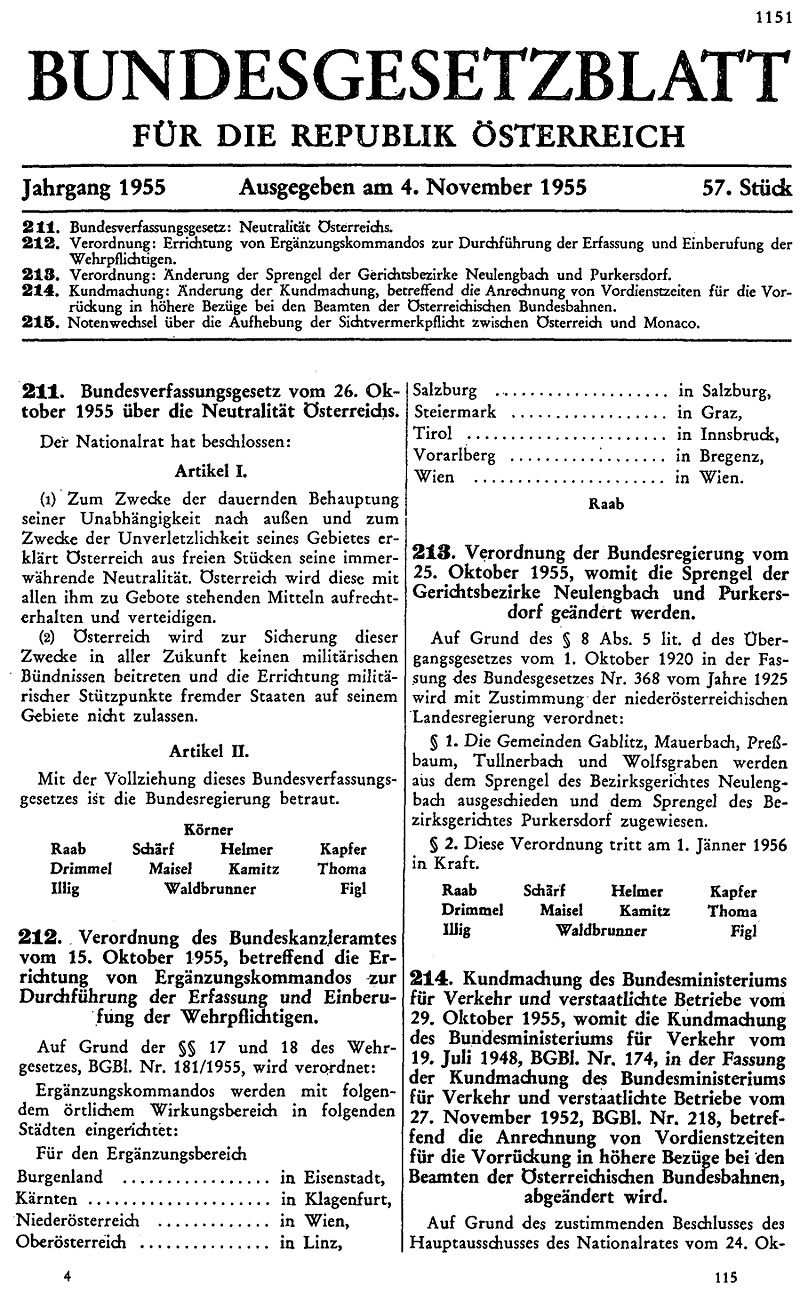
Is not neutrality without American security guarantees, with a powerful and aggressive neighbor like Russia, just an illusion?
This neighbor is already in Crimea fully and everywhere in Donbas – with arms, soldiers, control in everything but the name. In fact, Austria preaches neutrality while Ukraine is fighting a life-and-death battle for its country and people. Is this not a bit naïve? In fact, is not advocating an equal distance between the aggressor and the victim outrageous and morally very questionable?
Moreover, who would guarantee the neutrality of Ukraine? Do the people of Ukraine consent or is nobody asking them? Let us not forget that Ukraine was and is legally more or less neutral right now, protected by agreements like the Budapest Memorandum, the UN Charter, Helsinki Treaty of OSCE and several agreements and bilateral contracts with the Russian Federation. None of this prevented Russian aggression after Euromaidan.
Moreover, this will be done to achieve what? Unity and Independence like before 2014? Protected by whom and how?
A neutral Ukraine could (and will) never work
A neutral Ukraine will always be torn between the gravity of competing superpowers and torn apart once relations enter turbulent waters, like it happened with Russia after Putin’s 3rd term election, whose dreams of the past glory of imperial Russia could not be fulfilled without Ukraine. Euromaidan, the flight of loyalist Yanukovych, and the victory of pro-Western forces in Ukraine were the reasons he created an open conflict in Ukraine in order to control its political agenda. This cruel measure resulted in enraging the Ukrainians and creating a new consensus for Western integration as the only really framework to secure a long-term stability. The support public backing and support for membership in EU and NATO is now much higher than at any point of time before after 3 years of war in Donbas and occupation of Crimea. Now Ukraine and its elite and people really want NATO and EU membership and are ready to do what it takes for it.
Proposing neutrality is tantamount to proposing to surrender to the aggressor. And the Moreover, what will Russia give what is not legally already Ukraine’s?
The deadly price of neutrality for Ukraine
And this matters. What can Russia give? Normality? Peace? Withdrawal from where it should not be anyhow? And as a member of the security council of the UN, the OSCE, and the Council of Europe, should it not uphold international law, and not abide by it only as a kind of concession?
Here the example of Austria matters again. In reality, there is no neutrality. If you are not an official ally you still have to decide, or it will be decided for you which block is securing you.
Your status as a NATO ally makes your future in case you are attacked pretty clear: you are still on NATO's side, just on a less auspicious basis - as a vassal who has to run for cover and is not granted security by a treaty obligation, but as a concession on terms of the protector. And this protector's choices of means in time of war might be not what you look for.
Or if you are strong in yourself like India, or far away, like South America, or you do not matter.
Ukraine is none of those things. Close to Russia and having been part of the Russian empire for most of history, it can never be neutral. Asking Ukraine to stay neutral or turn neutral in exchange for vague prospects of unity with Crimea and a Donbas dominated by Russian media and political control when decoded translates to:
"we never wanted you anyhow, sorry about your Euromaidan and the war but could you please now make peace again with Russia and submit to Moscow so we can live in peace again and get rich by dealing with Russia, and if necessary with Ukrainian oligarchs again. You Ukrainians better behave otherwise your big brother East is getting angry, justifiably angry with us again, that we want to take away their favorite toy."
Thus, neutrality can either be used a term meaning submission to Moscow or for being like Austria was – being under American protection in everything sans the name, not on a treaty basis but in real strategic terms. What that means for Ukraine let us discuss further.
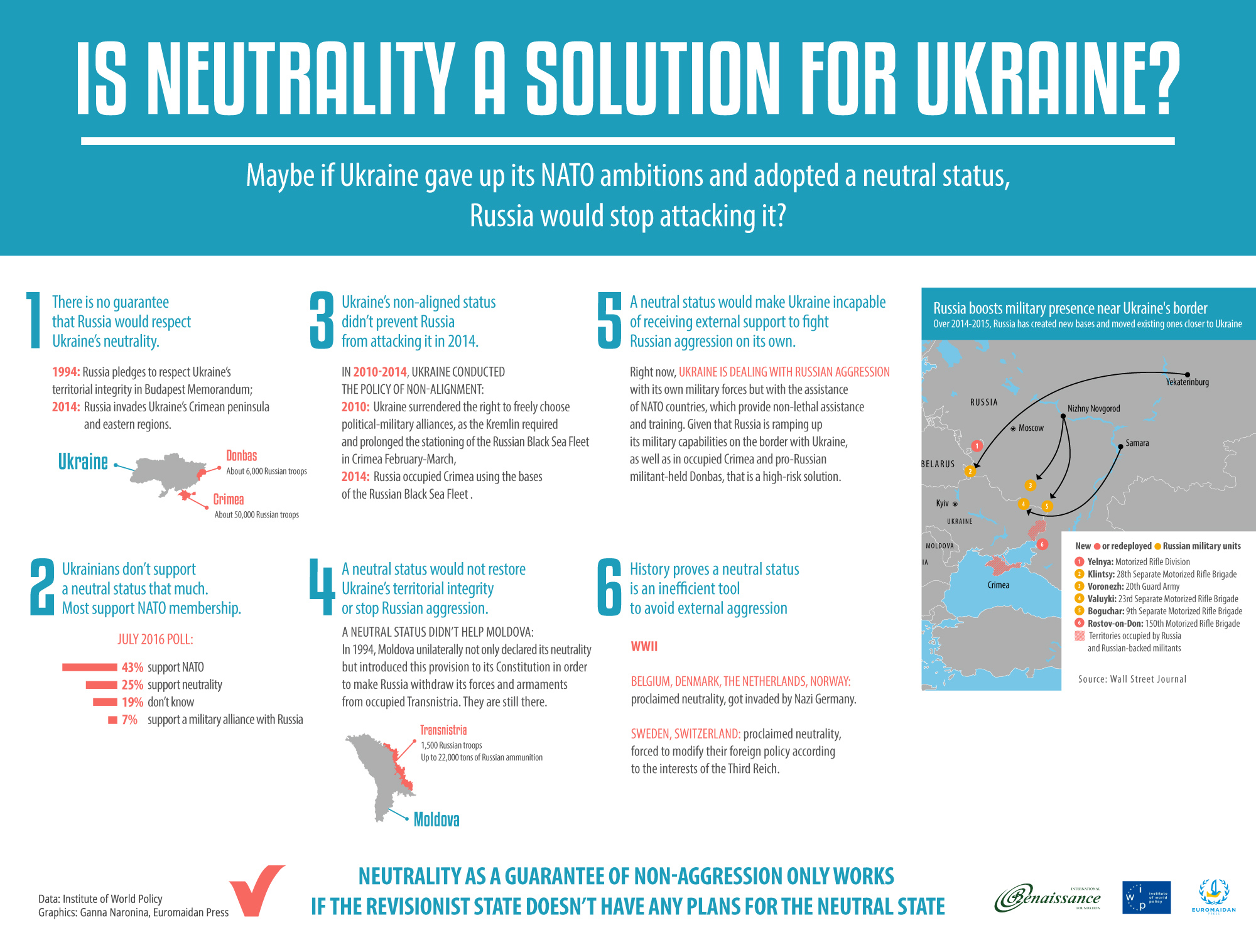
NATO industrial capacities matter in the long term
Ukraine is mainly flat land. The Dnipro river and Carpathian mountains are the only significant geographic features in the largest country fully within Europe. If you are a NATO member, your borders are secured by mutual guarantees.
Arguably, American power remains the ultimate force in the world for decades to come. It can be, and is, debated when and how the extent of American protection and mutual defense will be activated (basically meaning, will the US use nukes to defend Estonia's Russian border?). This all can be discussed, but the whole idea is that you challenge American power directly when violating a NATO member, and you better think twice or 3 times.
Without arrogance, simply taking the combined industrial power of NATO members and for example Russia and China today, and comparing GDP or defense spending, it is a wise guess that in a military confrontation, cold or hot, the industrial, financial, technology, innovation, decision-making capacities and political institutions of the West led by the USA will most likely win.
Modern Russia knows that very well and so does China. It is the reason why President Putin takes desperate and diligent care not to be seen officially invading Donbas.
Neutrality protected by tactical nuclear weapons – the bitter taste of Austrian neutrality
But back to the Austrian neutrality and its meaning for Ukraine. That means that given the potential of a Russian land attack, it is for Ukraine to defend itself alone, and then hope for support from the US, the only power to intervene, and with the US deciding with what means.
Additionally, we need to face the reality of having of a superpower as a neighbor. Russia will always be stronger than Ukraine, the US and European forces at peace standards are not ready for such a war in Ukraine, and the industrial potential to mobilize takes a year or two to change from peace to full war mobilization. Sure, the west will win, but first, the aggressor will prevail, like it is with all aggressors.
Similar to Vienna which could and would not be defended, eastern Ukraine's close proximity to Russia's mobilization area, with no natural borders in between, basically leaves the whole area open to a Russian advance. If Russia attacks eastern Ukraine and stops, no NATO alliance will act, no American President will threaten with his nukes, and Ukraine will be alone, very much like today until gradually Western public and industrial capacity kicks in and Russia runs out of steam.
But what if Russia looks to move west of the Dnipro? The same logic as in Austrian neutrality applies: no American President who knows he needs a year to build tanks and a year to bring them over the Atlantic will allow this to happen, and suddenly his Generals will recommend using tactical nuclear weapons to stop Russian tanks in eastern Ukraine. Better than in Poland.
Will the Russian tanks be stopped by America's threats of using nuclear weapons, or will they be used, like McArthur wanted in Korea and Truman did not allow? Who knows. Such a neutrality is quite a terrible prospect, basically turning eastern Ukraine and not just the Donbas in a potential war area with the potential of nuclear weapons used. And it is possible to use them and not start a full-scale nuclear war, but what about the people, the land, and the future of Ukraine?
Such is the nature of Austrian-style neutrality in reality.
Nuclear protection only possible under US umbrella
And who can want that? Submission to Russian power or being just a token on the great power chess board, bitterly remembering the Budapest memorandum and its value in 2014. Entertaining fantasies of restoring Ukraine's nuclear status and annoying the US is as well not helpful. It is tempting to make these threats, but Ukraine with its $90 bn GDP economy has not the resources to do it in reality. Nobody doubts Ukraine's technical and scientific skills, in fact, even North Korea has done it, so for sure Ukraine can do it with its talented people, but the case of North Korean is telling. Having nuclear weapons and little more, and only enemies around is not a very promising road. Money is better spent making friends in Washington and Brussels, Berlin, and Paris, and other EU and NATO capitals friendly t0wards Ukraine, meeting the real needs of real people now in Ukraine, and winning the minds and hearts of citizens and investors for post-Maidan Ukraine.
The Croatian, Albanian, Montenegro success models
So, where can Ukraine find real security? Only inside NATO and the EU.
To achieve this goal, Ukraine needs to stubbornly insist on it and build alliances with friends inside and outside NATO, and step by engage opponents to neutralize them. So did Romania, Bulgaria, Estonia, Albania, Croatia, and now Montenegro and all others who were previously not clear NATO candidates in the eyes of the American public but nevertheless joined the Alliance.
They are safe now and so will be Ukraine.
Now, the opponents of Ukraine's movement towards NATO argue that the occupation and war makes it impossible, that Germany and France will oppose the move like in 2008 and so on, so better not try and instead neutralize Ukraine, as many would be happy with its pre-2014 status of poverty and dependency in the Russian orbit.
But the choice is Ukraine's to make. Make it clear what you want and then communicate your sovereign decision. Convince the world. Nobody will resist, as your case is good, fair and just.
Germany as well became a NATO member divided and with Soviet tanks along a demarcation line. The German decision, the Western German decision is most relevant for Ukraine. If Ukraine says "yes" to NATO and EU, the unification will happen once the political and economic decisions allow.
NATO and EU membership are more important strategically than the recovery of Donbas or Crimea right now. Similar to West Germany, which for decades had not recognized the GDR either officially or morally, Ukraine and the free world will as well never recognize the Crimean annexation or the results of Russian aggression in Donbas.
And Ukraine will be member of EU and NATO for sure
The future of Ukraine is in EU and NATO and work and advocate this as long as it takes to make it a reality. Ukrainians are Europeans so it is time to fully join the European Institutions - nothing more, nothing less.
Neutrality – whether it be Austrian or another form - would be a tragic mistake. NATO and EU accession worked its magic from Estonia to Bulgaria and now it is time for Ukraine. Perhaps Ukraine will be in NATO before Austria, becoming a vital pillar of European and Western Defense at the border to the Russian Federation, which will secure Austria as well.
Who would have thought that possible 30, 20 or 10 or even 5 years ago?
About the author
